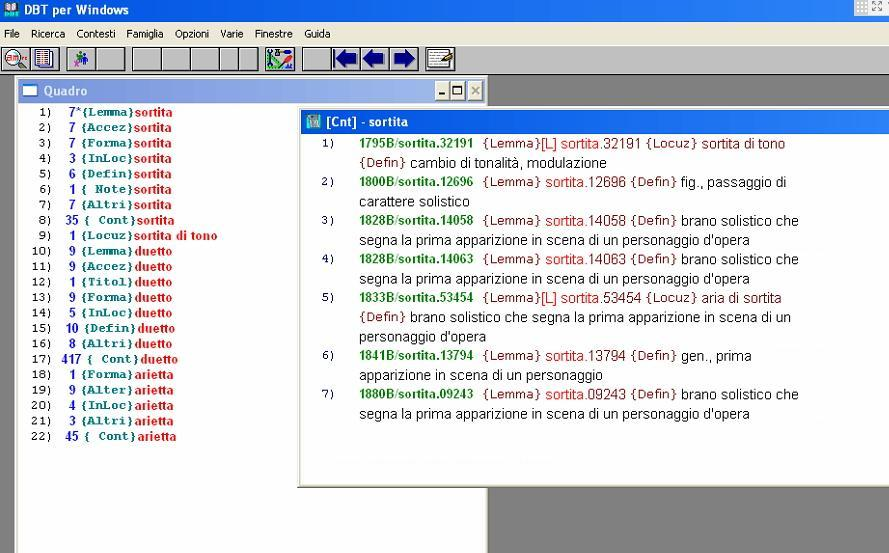4. Objectives of the project and methodology
Albeit the main objective of the project is to produce, preserve and make available the digital edition of Bellini's correspondence, there are some elements of innovation that distinguish this initiative from other similar projects. Besides the online publication, the digital edition will be available also within the setting of the Belliniano Museum, thus allowing visitors to "touch by hand" the original documents for a more immersive experience.
The experimentation of the tagset correspDesc of the TEI header and the use of the LOD paradigm in the activity of annotation of the letters (see 4.3) as well as the implementation of a prototype environment (see 4.4), constitute some further elements of innovation.
Finally, as expected from a project of this nature, the texts that will be made available and shared online, will make Vincenzo Bellini known to a wider audience of non-experts.
In agreement with the experts of the domain, the initial phase has been focused on the digital edition of Bellini's letters and on cataloging and metadata encoding. The production of this edition envisages to work on two technological fronts in parallel: on the one hand, the TEI encoding of textual phenomena and metadata, on the other hand, the description of the relevant entities by means of formal vocabularies defined by following the Semantic Web technologies.
4.1. Metadata encoding
The Management of the Museum has made available an inventory of the manuscripts (written in the years 2000), some lists of documentary materials in the library, and some objects kept in the Museum. These lists do not adhere to specific conventions and they are therefore not present in national or international catalogs (SBN, SAN, Internet Culturale, etc.). In the elaboration of a systematic catalog, functional to making the Museum's heritage available on the Web, cataloging rules for the musical and documentary material at the base of the SBN platform were taken into consideration: uniform title for the scores, catalog manuals, description of the manuscripts. Where not present, a unique identification code has been created for the documents with its specific signature. The other elements of Bellini's heritage have been meta-dated according to the catalog sheets of the Istituto Centrale per il Catalogo e la Documentazione. In this way it will be possible to exploit the sharing protocols provided by the Online Public Access Catalog (OPAC - Z39.50), useful to encode appropriately the access information, and to index the document to be cataloged.
Metadata are currently being published in national catalogs, and the creation of an ontology dealing with the contents of Bellini's heritage is planned, by extracting the concepts of particular interest which are present in the letters (names of persons, places, etc.) and in other documents, and by referring to standard metadata schemes such as RDA, FRBRoo and FOAF. Moreover, with a view to the reuse and interoperability of the Semantic Web resources, an accurate analysis of existing ontologies, vocabularies and thesaurus has been carried out, with particular attention to the music domain; therefore, the above mentioned RISM project for the musical domain and the VIAF and GeoNames resources for the other concepts have been taken as reference.
All letters and documents that have been reorganized and cataloged are currently divided into different sections, each of which an identification code has been assigned to. In line with the criterion adopted in the most recent critical edition of Bellini's correspondence ( ), the missives have been organized in chronological order with respect to the present or presumed date of the letter and the abbreviation LL has been chosen for the missives attributable to Vincenzo Bellini and to his family of origin.
In the current exhibition of the Museum, the autographed letters of the Catanese composer are all displayed in the windows of the birth house, with the exception of one letter. The LL1 acronym has been assigned to the group of Vincenzo Bellini's autographed letters which has a total of 41 units. The 85 letters addressed to the composer from Catania were collected, instead, under the acronym LL2. An additional letter was also found, the location of which was unknown at the time of the recognition carried out by Seminara in . Several missives have also been found, which can be traced back to a time interval following the death of Vincenzo Bellini. These are letters, or more frequently drafts of letters addressed to the father or to other members of the family. Furthermore, two other categories have been devised, LL3 and LL4 - with 39 and 48 units respectively -, which have been organized according to the criteria previously described. A small group of letters (14 missives) has been grouped under the LL5 acronym and consists of letters sent by people not belonging to the Bellini family addressed to different recipients.
The signature of the individual documents (e.g. LL1.4) identifies the group which the document belongs to, followed, after a dot, by a progressive serial number. In the quite frequent cases where the same unit contains more than one letter, it has been preferred to assign the same signature to both letters with the addition of I and II to show that it is a "multiple" document. All the signatures assigned to the individual units, when they were inserted in SBN, were accompanied by an alphanumeric code that contains information about the institution where the document is located; this is the code assigned by SBN: for the Belliniano Civic Museum of Catania, the string that precedes the signature is CT0031, so, for example, the first letter of Bellini is marked as CT0031_LL1.1 and this represents his unique "identification code".
The elements highlighted in the cataloging phase are functional to the description of the main characteristics of each document and concern not only the elements relating to the sender, recipient, dating, etc. but also the current location of the cataloging resource and its physical characteristics, as the format, and the language in which the text is written.
4.2. Digitization of the Bellini correspondence
Most of the paper documentation existing at the Museum (mostly handwritten) was reproduced in digital format. With regard to the letters written by and addressed to Bellini, about 600 photo shots in three different formats (TIFF master at 600 dpi with a color depth of 24-bit RGB, JPEG compressed to 300 dpi and JPEG compressed to 100 dpi) were taken. The relative descriptive metadata encoded in MAG format has been attached to each set of images. The scanning activity was carried out in the Museum's rooms to protect the extreme delicacy and preciousness of the original documents. To this end, a portable digital high-definition colour planetary/robotic scanner, with a special plane to minimize the effects of deformation and cold neon lighting, has been installed. The images will be cut out, balanced and processed in order to offer a digital facsimile representation that corresponds to the original as much as possible.
4.3. Letters encoding
After the phases concerned with the metadata encoding and with the digital acquisition of Bellini’s correspondence, the documents were analyzed to identify the textual and metatextual information which had to be marked up. As indicated supra, the digital edition of Bellini’s letters is based on data that are already published in the philological study conducted in .
Within the BellinInRete project, the edition is conceived to follow the image-based encoding, consequently providing the facsimile reproduction of the original document in parallel with the electronic version of the transcription. The textual and structural phenomena have been appropriately encoded in TEI XML format in the electronic document.
In particular, in this edition some textual phenomena have been taken into account that were omitted in the printed edition for editorial reasons. Moreover, some information was added within the encoded texts by exploiting linking mechanisms both to external resources as well as to internal files.
The added value of this digital edition is not limited to the metatextual data associated with the digital transcription of the letters. Indeed, the user is able to view the digital reproduction of the autographs, coming in contact with the emotional charges of Bellini (evident in the anxious profile of his writing), with his morphological and lexical uncertainties (visible by the large amount of self-corrections), but also with his correspondence to the "rules" of the epistolary grammar of the nineteenth century.
One example of these rules is the use of the so called "dar la linea", namely, the amplitude of the space between the introductory formula and the body of the letter and between the conventional closing formulas and the final signature, which depended on the hierarchical relationship between the writer and the addressee: an aspect of Bellini's epistolary writing that appears to be closely related with the multiplicity of stylistic levels (confidential or formal) consciously adopted by the musician according to his correspondents.
Often the letters present successive third hands annotations made by catalogers. These metadata were managed with the TEI handDesc module.
The analysis phase produced an encoding scheme suitable to record and process data related to the selected corpus. The encoding provides scholars with advanced navigation features that can describe historical-critical information, displaying, next to the transcribed text, the critical apparatus drawn up by the editor.
The defined XML scheme considers the adoption of two important extensions of the TEI Header: the correspDesc and the msDesc elements. The first one, placed in the profileDesc descriptor, is suitable to record the correspondence; while the second one, situated in the TEI "manuscript description" module, is useful for the physical description of the letters. Furthermore, the msDesc elements allow to structure all the characteristic aspects of the manuscript, encoding the descriptive, codicological, structural and content data.
The encoding work was carried out on a representative sample of letters. For example, the manuscript letter that Vincenzo Bellini sent from Puteaux to Carlo Pepoli dating 26 June 1834 has been encoded with LL1.16 signature. This document corresponds to the 16th Bellini's letter kept at the museum in chronological order.
The current signatures and collocations of the letters, defined in the cataloging phase, have been appropriately encoded by using the msIdentifier element.
Specific interest was given to the extratextual aspects related to the physical layout of the letters. Generally, the letters themselves also have the purpose of acting as envelopes. In fact, the letters are folded on themselves and postmarks and wax seals are sometimes affixed on them, see for example the folio in . The TEI msDesc module defines all the descriptors to suitably encode all the necessary information regarding preservation conditions, the type of paper, the description of the stamps and to the seals, the size and modality of folding the folio, the collation, and other codicological and archival metadata.
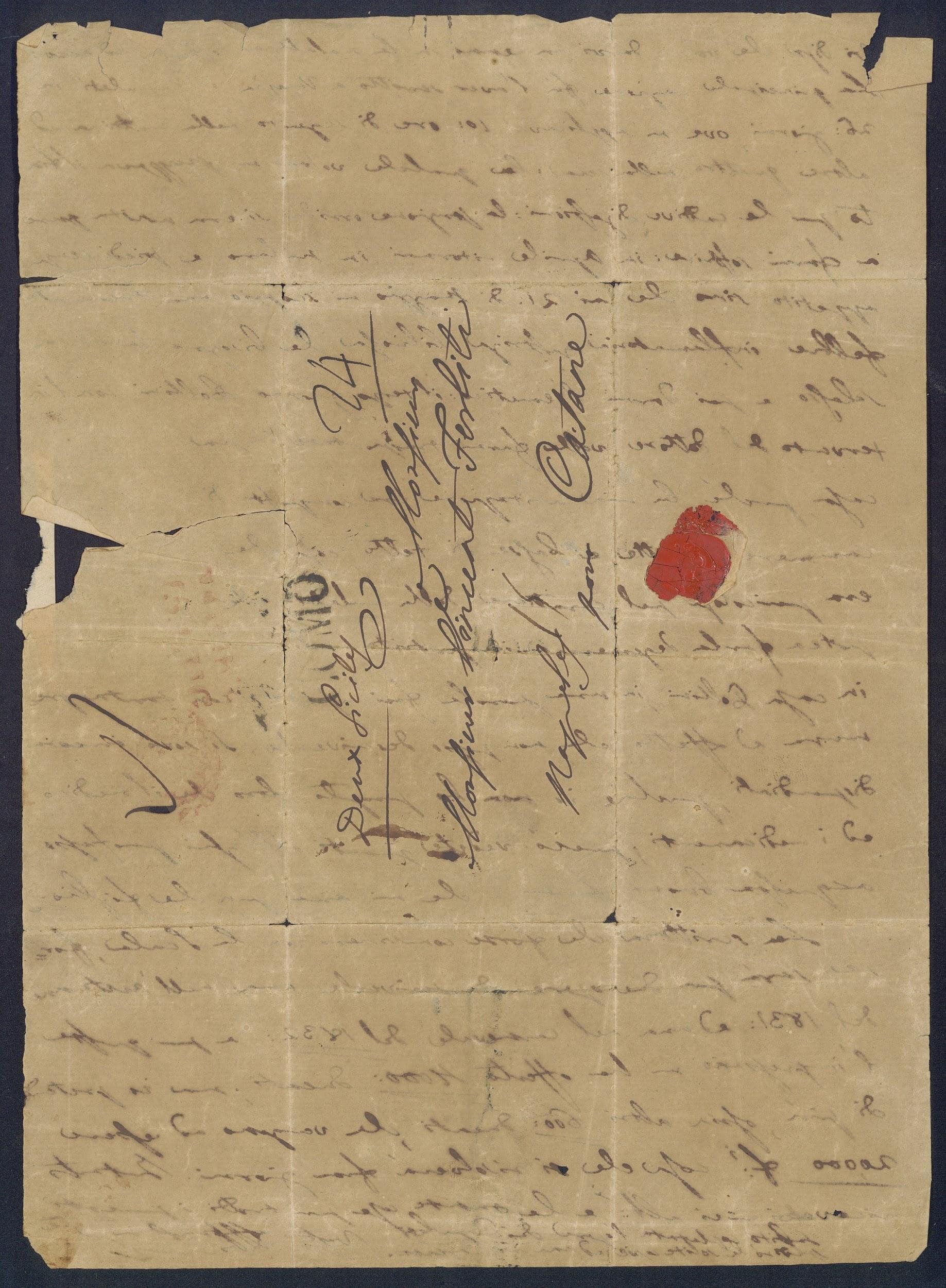
The adoption of the correspDesc element has allowed us to enrich the encoding of the logical-structure of the document (sender, recipient, date of sending, date of receipt, communication context, closing of letters). shows an example about the correspDesc tagset for the LL1.16 letter.
In addition to the traditional encoding concerning the structural hierarchies of the document and the logical hierarchies of the text, the schema also allows to represent other important information related to the content of the letters (through the front, body and back elements of the text node).

Given the method through which the document is folded and enveloped, the front element contains information about both the addressee and the description of the stamps, as well as to other regions of interest upon the selected folio (hotspots). The content model of the body element contains, instead, the text encoding of the letter, which is conducted line-by-line, taking into account alignments, headlines, newlines, spelling phenomena (such as abbreviations, underscores, deletions, etc.), the addressee (encoded by adopting the opener type node), as well as the introductory and farewell formulas, and the final salutation with the author signature (closer). In particular, the introductory and farewell formulas have been encoded through the salute ( ), responding to formal stylistic choices of the maestro, as already mentioned supra. Finally, the back element contains bibliographic references to other critical editions of the letter, as well as editorial notes and further information extracted from the printed edition. Notes, generally, have the purpose of contextualizing what is expressed in the text; however, no new notes have been created when linking an item encoded in other lists is sufficient to deepen and understand the selected textual fragment, as will be explained infra.
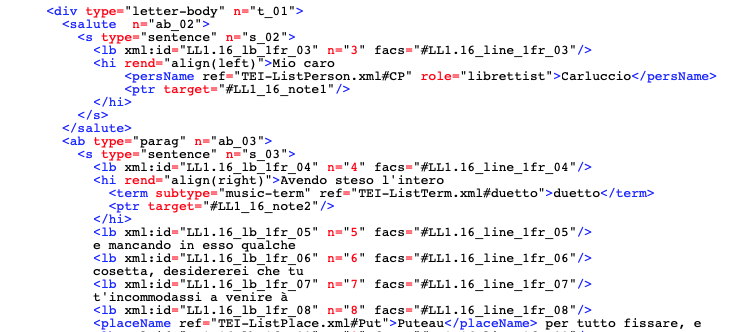
Indeed, the museum context and the educational purpose, underlying this digital edition, have led us to provide a set of lists of named entities, explicitly cited in the text or implicitly referenced. These lists are accessible within the context of the visualization of the letters, through the use of inline pop-up and references to authoritative online datasets. A list of people (TEI-ListPerson) has been created in order to be always available and independent from the contexts in which the names appear. This list includes the addressees and the persons present in the text, mentioned or implicitly referenced. Most of the information relative to each entry has been taken from the notes of the source critical edition. A short biographical note and the social role (count, baron, etc.) have been appropriately defined; the role in the musical context (librettist, tenore, etc.) has been encoded using the syntax of the guidelines of the Music Encoding Initiative (MEI). External references to the authoritative RISM and Treccani repertoires (Biographical Dictionary) have been added as well.
By virtue of the divulgative nature of the edition, it has been decided to create the list TEI-ListOrganization, which includes the theaters mentioned in the text, and the theaters where the Opera premieres took place. This list has been created according to the Treccani repertoire by using the orgName and listOrg elements.
The list of places (TEI-ListPlace) contains the places where people were born and died, the places mentioned in the text and the cities where the Opera premieres took place. The external reference to the Geonames dataset is always added, as well as the reference to the Treccani dictionary.
It has been chosen to include in TEI-ListTerm both the words explained in notes in the reference edition, and all the occurrences of terms specifically belonging to the musical domain (duetto, sortita, atto, etc.) and to the context of musical performances (tenore, spartito, libretto, etc.) taken from the book edited by Della Seta ( ).
In this digital edition the internal and external bibliography is managed with two different lists: TEI-ListWork and TEI-ListBibl. The first one concerns the musical compositions (opera, musica da camera, etc.) made by Bellini and other authors (directly or indirectly) mentioned in the letters considered significant in the life and works of the composer. Since Bellini refers, in most cases, to his ongoing works, the term indicated in the list is conceptually associated with Work or Expression according to the FRBR criteria and not to Manifestation or Item. However, in TEI-ListWork we recorded a brief descriptive note extracted from Seminara's notes and integrated with information on the first performance (theater, place and date) as well as references to the Treccani and to Wikipedia pages. According to the MEI guidelines the elements that identify the intellectual content in the musical context were also considered, such as composer and librettist, as shown in . On the other side, TEI-ListBibl contains the bibliographical references about critical editions of letters and repertoires.
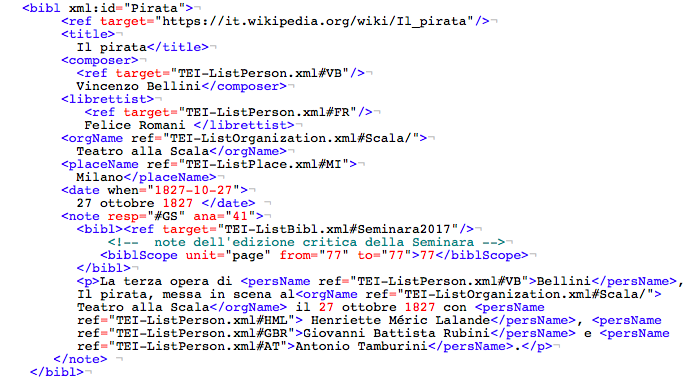
As mentioned supra, the edition presents the digital reproduction of the manuscript in parallel with the electronic transcription, based on a line-by-line synchronization. In order to fulfill the production of the digital edition and its wide exploitation, all the phenomena upon the regions of interest within the facsimile image are encoded and made available for further machine processing: For example, the image areas yielded from the folding of the folio have been thoroughly encoded. Specifically, the standard encoding mechanism, adopting zone elements and points attribute for the definition of the regions of interest, has been used. This encoding approach makes use of the TEI facsimile module encompassing the surface, graphic and zone elements. The stamp zones, the address zones and those ones containing second and third hands have been identified and recorded. In the facsimile images of LL1.16 letter, zones corresponding to text lines, retro-recto and retro-verso without content, addressee, second hand, third hand and stamps have been managed. The regions of interest encoded in the fronte-recto folio are shown in , as well as the line-based highlighting within the address area. Thanks to this encoding of the image zones, different levels at different granularities of text-image linking can be managed, enriching the edition by means of notes and references starting from the facsimilar of the digital document. Concerning the image retrieval aspects, the API implemented by the International Image Interoperability Framework (IIIF) was used ( ).
In such a way a detailed browsing of the correspondence content and context has been achieved, linking the most relevant information (e.g. names entities, catalogs, bibliography) to authoritative online datasets. Specifically, domain datasets such as RISM have been preferred to the more general purpose datasets like Dbpedia.
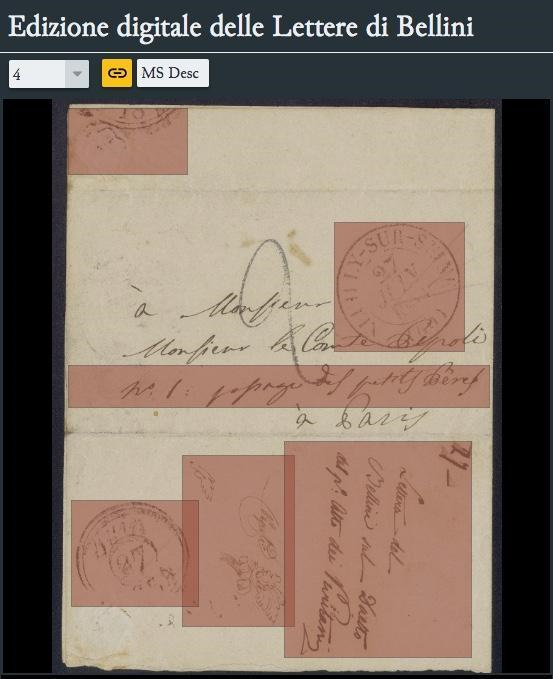
4.4. The digital scholarly environment
One of the most innovative aspects of BellinInRete digital correspondence is the work carried out towards the production, indexing and visualization of the digital edition. To this end, a Web prototype ( ) has been implemented to process Bellini’s manuscripts based on the specifications and encoding choices introduced supra.
As described in previous sections, the digitization process of Bellini's letters has started by organizing the catalog into an electronic database and by acquiring facsimile scans of the original manuscripts (as is typically done in these kinds of projects). The second phase of this process involved the transcription and the digital encoding of the original documents, which are part of the selected collection. Although the digital representation of the letters is basically carried out by the aforementioned steps, the actual availability of the Bellini corpus cannot be considered fulfilled if the entire corpus is not published using some kind of Internet service ( ). In particular, both scholars and interested users, are nowadays in the habit of consulting their sources by means of Web browsers through open access modalities ( ). In the light of all the above, it has been decided to publish the digital edition of Bellini’s correspondence by developing a Web environment based on two extant systems: 1) Omega Web services for scholarly texts ( ); 2) Edition Visualization Technology (EVT) for Web presentation of scholarly texts ( ). At the end of the development process, the two systems (described infra) will cooperate in an integrated environment for digital scholarly editing suitable to produce, exploit and disseminate Bellini’s correspondence ( ).
Omega has been conceived as a modular digital environment for textual scholarship based on a microkernel architecture and on a collection of Domain Specific Application Programming Interfaces (DS-API). The development of Omega, carried out by a group of researchers and technologists working in Pisa at the ILC, seeks to promote critical text enquiries by means of computational tools able to efficiently model and handle textual, linguistic and semantic analyses. In order to reach this challenging objective, the digital environment adopts the Object-Oriented Analysis and Design (OOAD) paradigm and the Semantic Web technologies, paying particular attention to involve textual experts in the development team, as dictated by the Domain-Driven principles and patterns. In addition, this project takes into account both the requirements of textual scholars and the needs of software developers. Indeed, the Omega microkernel provides developers with the basic functionalities needed to load, index, annotate, and query the domain entities for text representation and processing. These entities are reusable text abstractions composed both by a set of minimal elements such as the source element, the annotation element, the locus element and by a set of operations allowed upon these elements. In this way, it is possible to implement a flexible architecture of the digital environment by adding several layers of functionality one over the other, which end, on the top of all, with a layer of RESTful services.
The well-known EVT tool aims at publishing digital editions encoded by following the TEI-XML guidelines. Although the principal objective of this tool is to help textual scholars in their digital studies providing a lightweight and compact Web environment to create digital editions, the project team has been developing special views and use-cases to arrange requirements for the general public to better run and understand the content of the corpus. EVT has been completely conceived and implemented with a client-side architecture and comes with a user-friendly interface, exploiting different levels of editions (facsimile, diplomatic, interpretative, and critical). Currently, EVT is freely available in two different versions (EVT1 and EVT2) which have some differences both in terms of software architecture and in terms of functionality. Although the EVT2 version has a modern Web design and is designed to be more flexible compared to EVT1 version, this latter, although the core parser is based only on the XSLT2.0 technology, does still implement more features than the newer one. As a matter of fact, EVT team is hardly working on fulfilling the gap and achieving a feature parity between the two versions. EVT project provides a fitting starting point for the Bellini prototype as it is able to suitably manage TEI-encoded texts equipped with the corresponding facsimile images. Furthermore, the EVT instance for BellinInRete digital correspondence provides facilities specifically made for non-experts people such as didascalic notes, biographic descriptions of cited people, explanation notes about places, events, organizations (named entities), as well as exegetic comments about domain terminology e.g. words like duetto
or atto
(see and ). Indeed, EVT will implement different views suitable for generic museum visitors in Italian language.
To date, the ongoing Web prototype of the digital edition is publicly available and hosted on the CNR servers. shows the current state of the environment considering only one letter identified by the LL1.16 signature.
Specifically, once the TEI-encoded document has been sent from the back-end (server-side, the Omega sub-system) to the front-end (client-side, EVT sub-system) by calling an asynchronous RESTful service, the whole presentation and analysis of the letters occurs on the browser side. In particular, the features, provided by the EVT tool, have been customized to meet the requirements of the BellinInRete project. Thanks to this customization work, the second version of EVT has been equipped with a highly performing image viewer with zooming and tiling capabilities made available by integrating the OpenSeaDragon JavaScript library. Moreover, other functionalities have been developed and integrated into the environment, which now supports text-image linking, hotspots, and search capabilities. These new enhancements have also reduced the gap between the two current versions of EVT, reaching, in this way, a substantial feature parity between them.
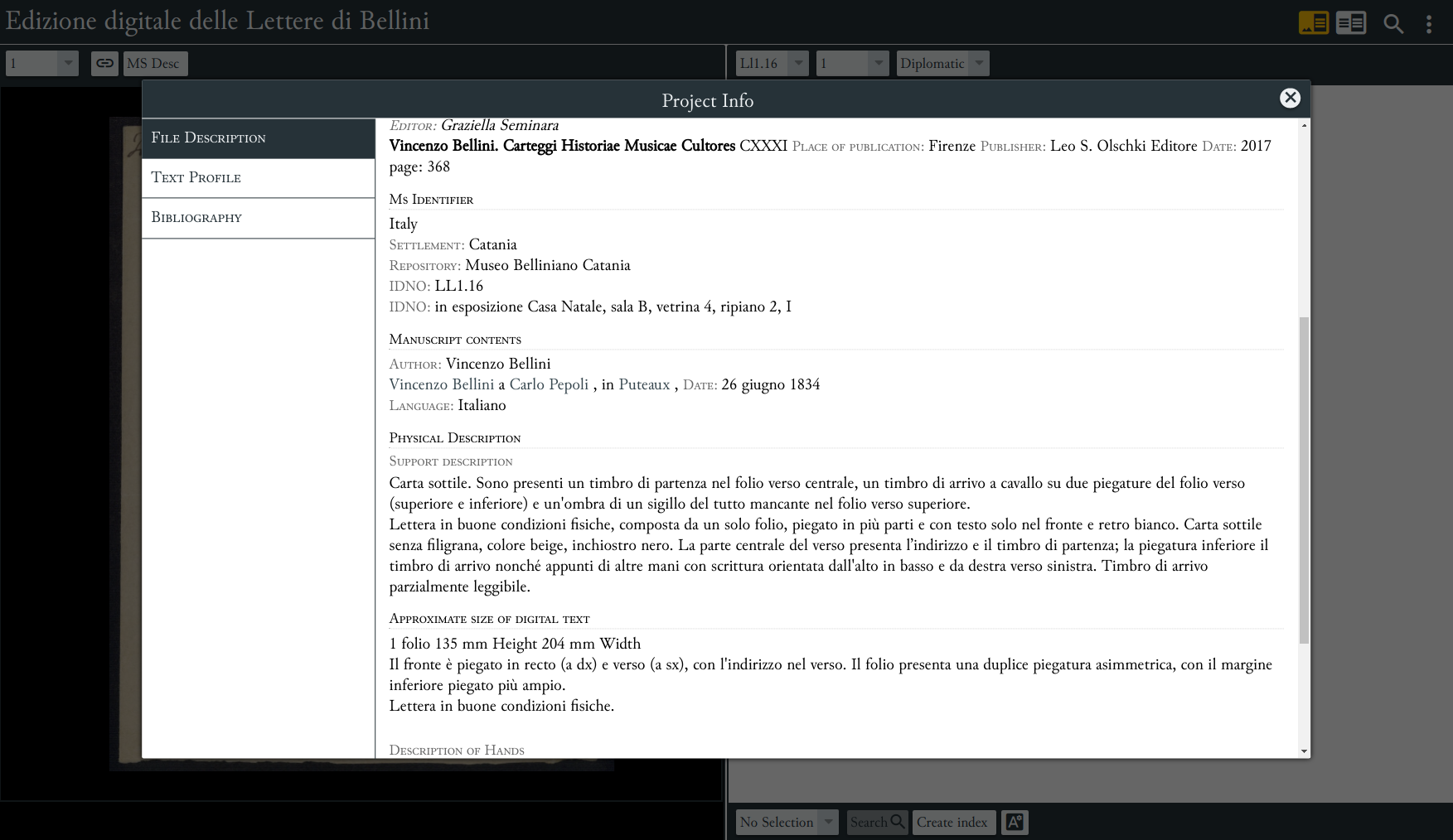
, and illustrate in details the prototype implemented so far. In fact, throughout the Web platform it is currently possible to visualize data regarding the correspondence description and the envelope modality, encoded, as described in the previous sections, respectively by means of the correspDesc tagset within the profileDesc of the TEI header and the front part of the text element. Furthermore, it is available a dedicated panel which shows on the screen the entire description of both the primary source and the BellinInRete digital correspondence. These data have been encoded through the msDesc tagset and the projectDesc elements of the header.
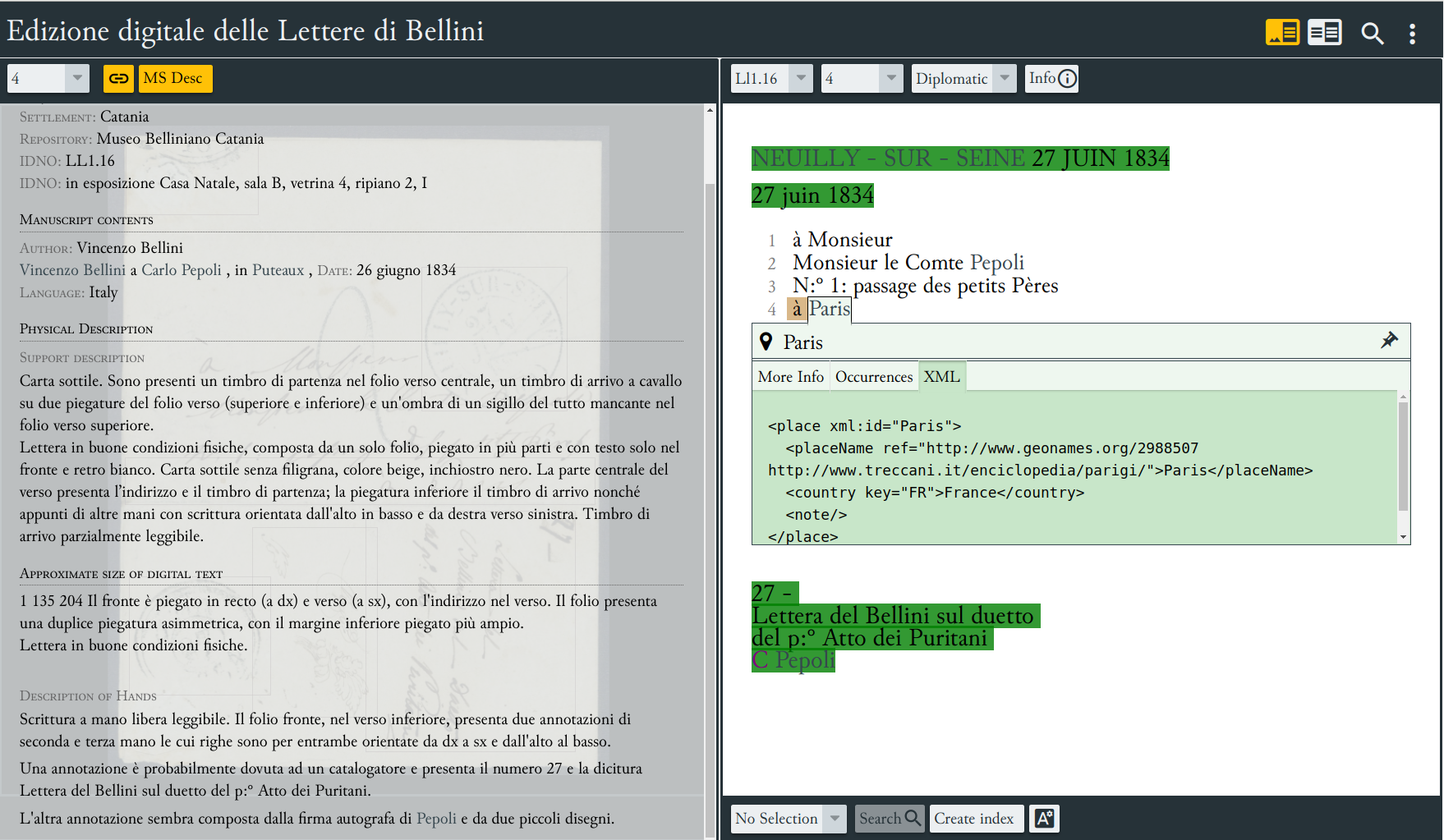
The digital environment also provides features to handle different kinds of lists such as name entities (persons, places, organizations), bibliography (performance works, books, etc.), the collection of the pages, the collection of the documents, and others. Moreover, resulting from the work conducted within BellinInRete, it is now possible to link a high-resolution facsimile image with the corresponding textual transcription accompanied with zooming, rotating, and panning functionalities.
Finally, the Bellini’s correspondence digital edition provides also some sort of critical notes besides the main text as well as the highlighting of parallel lines in the text and the corresponding image, the handling of hotspots upon the selected image zones and a useful search engine, thanks to which it is possible to query for text passages containing specific words or specific characters ( ).
The Graphical User Interface (GUI) in presents the description of the source manuscript, on the left hand box and, alternatively, on the right hand box, the envelope information which was written on the fronte-verso surface of the original document. The screenshot also shows the XML encoding of the Paris place name, plus the transcription of the stamps data as well as the text which has been added by later hands (highlighted in green).
The screenshot in shows the main layout of the GUI from which scholars and interested users can activate several interactive Web functionalities. For example, in the left-hand box the Web environment provides users with a highly performing image viewer which, using tiling capabilities, is able to handle scans with a great resolution. Moreover, the Graphical User Interfaces allow scholars to synchronize text and image at line granularity as well as to search keyword in contest (KWIC) thanks to a new search engine, developed from scratch ( ), and to deepen the description for each encoded name entities. In fact, it is extremely useful the change offered by the system to access the information encoded in the documents every time that a term occurs within the text, where a traditional reader of printed-edition has to search for the first occurrence of a lemma to retrieve the corresponding information.
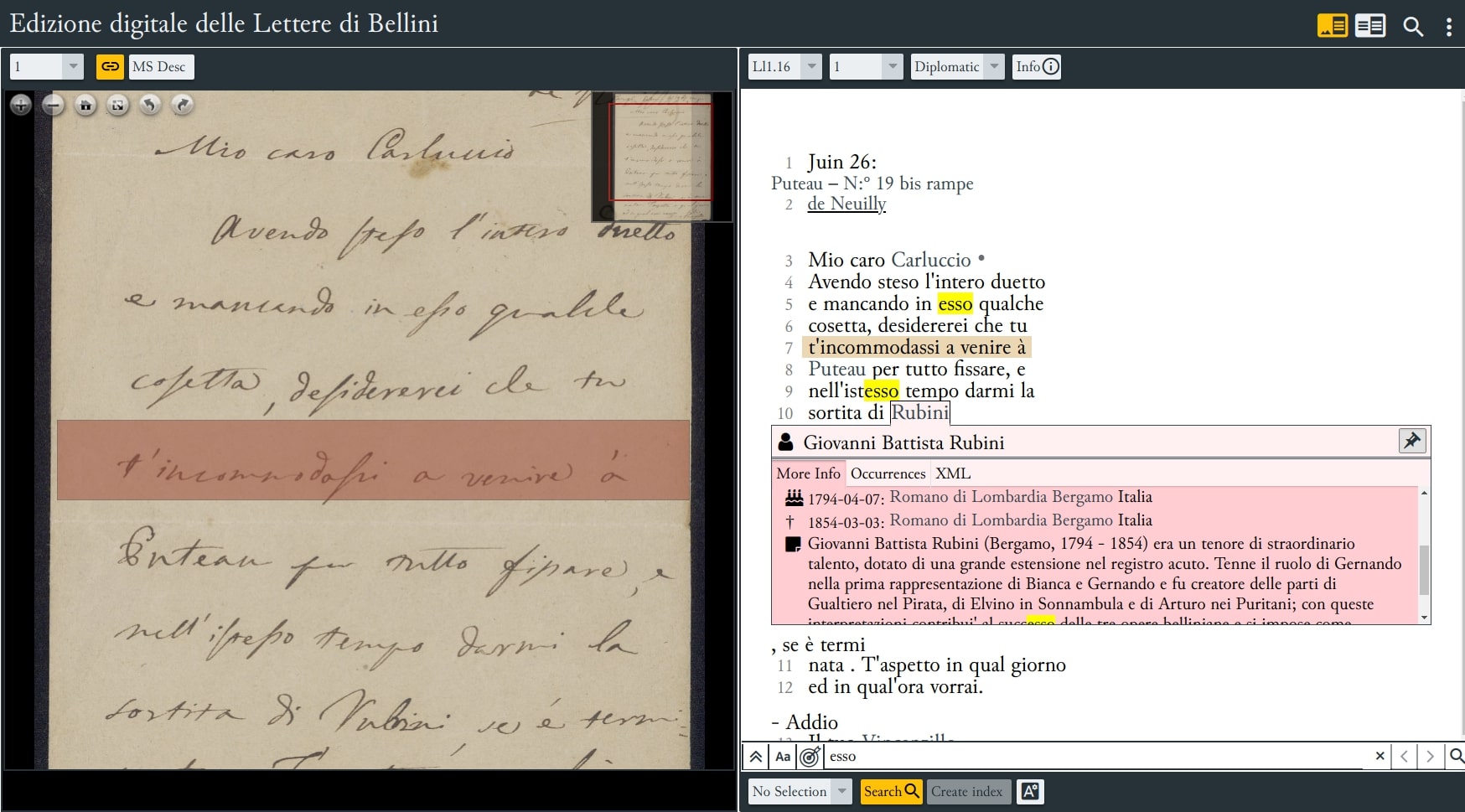
Finally, illustrates some other useful features to automatically handle the hotspots encoded upon the images as well as showing the notes that accompany the main text. The project leaders have been paid a great deal of attention in encoding as much extratextual descriptions as possible, thanks to which, by clicking on the highlighted terms, the digital prototype provides end-users with references to people mentioned by Bellini, to Opera institutions, to places, as well as to numerous technical "lemmas" that appear in the letters. Particularly interesting is the case of the so-called voci (description entries) largely concerning the morphology of the Italian opera house (aria, duetto, cabaletta), and consequently are easily accessible also to readers not familiar with the vocabulary used by the Italian opera composers of the nineteenth century.
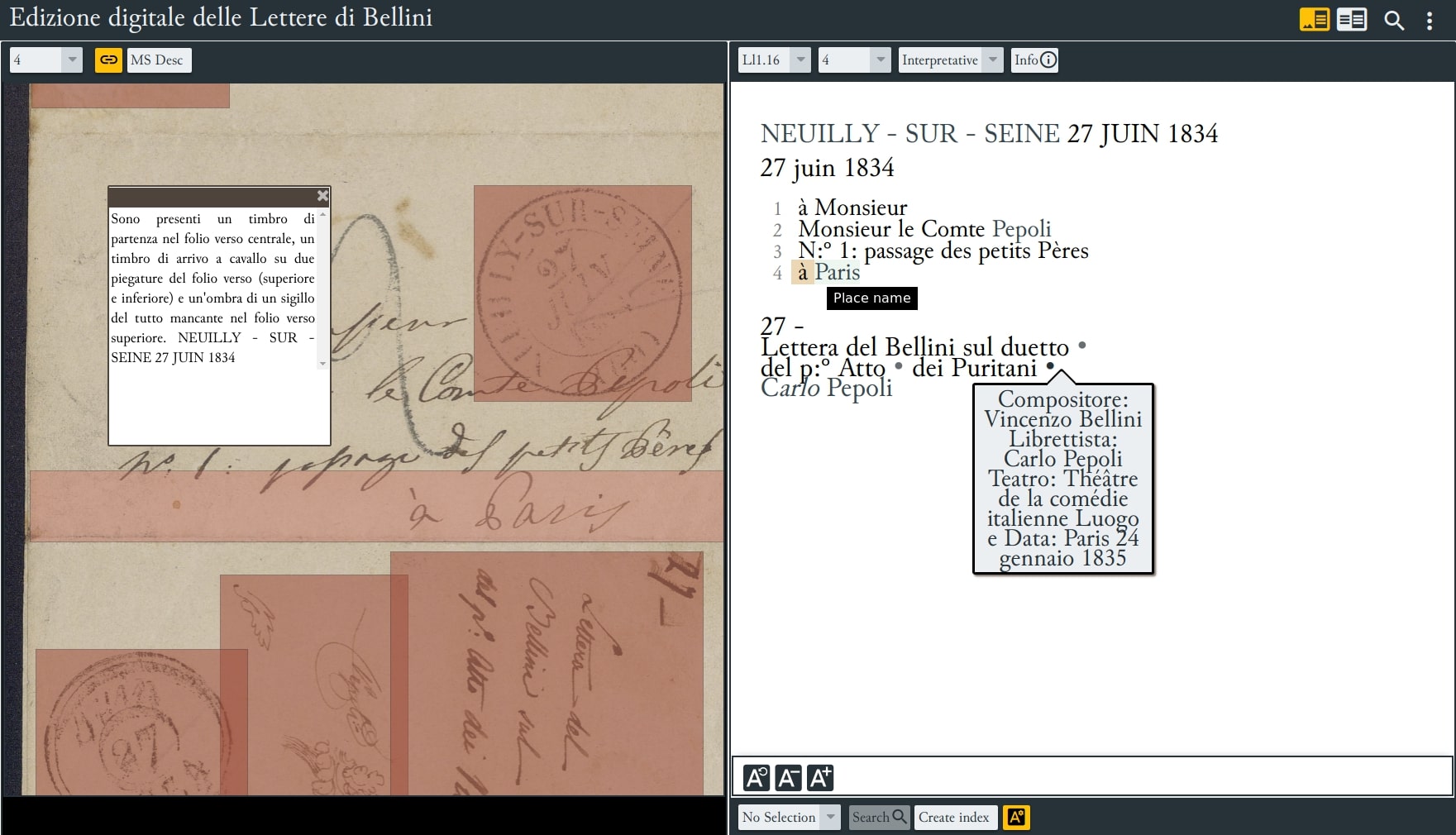
In order to ease the maintenance and the long-term preservation of both the digital edition and the project resources, open source technologies and well-received standard formats have been adopted. By doing so, the risk of digital obsolescence is drastically reduced. Indeed, special attention has been made to be compliant with the FAIR data principles (Findability, Accessibility, Interoperability, and Reusability), in order to support information management and interchange along with data processing tasks. Moreover, we plan to publish the digital edition under the CLARIN-IT umbrella in order to take advantage of a pan-European infrastructure devoted to maintain digital resources within the digital humanities field.
Ultimately, the Museum organization will be in charge of accounting matters related to the preservation and updating issues of the digital edition and software packages.
